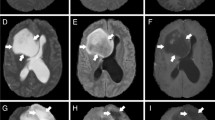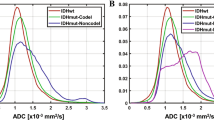Abstract
Objectives
To evaluate the diagnostic performance of the T2-FLAIR mismatch sign for prediction of isocitrate dehydrogenase (IDH)-mutant, 1p/19q-noncodeleted lower-grade gliomas (LGGs) and review studies with false positive results.
Methods
The MEDLINE and EMBASE databases were searched up to March 13, 2020, to identify articles reporting the diagnostic performance of the T2-FLAIR mismatch sign for prediction of IDH-mutant, 1p/19q-noncodeleted LGGs (IDHmut-Noncodel) using the search terms (T2 FLAIR mismatch). Pooled sensitivity, specificity, and correlation coefficient for interobserver agreement were calculated.
Results
Twelve studies including a total of 1053 patients were included. The median age was 43 (median; range, 14–56). The pooled sensitivity and specificity were 42% (95% CI, 28–58%) and 100% (95% CI, 88–100%), respectively. According to the HSROC curve, the area under the curve was 0.77 (95% CI, 0.73–0.80). Considerable heterogeneity was possible among the studies in terms of both sensitivity and specificity. A threshold effect was suggested and was considered to explain most of the heterogeneity. Four studies reported false positive results for the T2-FLAIR mismatch sign, including dysembryoplastic neuroepithelial tumor, pediatric-type gliomas, and non-neoplastic lesions. The 2 original articles with false positive results showed the highest sensitivities among the 10 studies included in the quantitative analysis, supporting the probability of the threshold effect. The pooled correlation coefficient was 0.87 (95% CI, 0.73–0.94).
Conclusions
The T2-FLAIR mismatch sign had a high specificity and interobserver agreement for the prediction of IDHmut-Noncodel. However, the sign demonstrated low sensitivity, and a few studies with false positive cases were also reported.
Key Points
• The pooled sensitivity and specificity of the T2-FLAIR mismatch sign for prediction of IDH-mutant, 1p/19q-noncodeleted lower-grade gliomas were 42% and 100%, respectively.
• Four studies reported false positive results.
• The pooled correlation coefficient was 0.87, suggesting almost perfect interobserver agreement.




Similar content being viewed by others
Abbreviations
- DCE:
-
Dynamic contrast enhanced imaging
- DNET:
-
Dysembryoplastic neuroepithelial tumor
- DSC:
-
Dynamic susceptibility contrast imaging
- FISH:
-
Fluorescence in situ hybridization
- FLAIR:
-
Fluid-attenuated inversion recovery
- HSROC:
-
Hierarchical summary receiver operating characteristic
- IDH:
-
Isocitrate dehydrogenase
- IDHmut-Codel:
-
IDH-mutant, 1p/19q-codeleted lower-grade glioma
- IDHmut-Noncodel:
-
IDH-mutant, 1p/19q-noncodeleted lower-grade glioma
- IDHwt:
-
IDH wild-type lower-grade glioma
- IHC:
-
Immunohistochemistry
- LGG:
-
Lower-grade glioma
- MP2RAGE:
-
Magnetization-prepared 2 rapid acquisition gradient echoes
- NGS:
-
Next-generation sequencing
- PCR:
-
Polymerase chain reaction
- PRISMA-DTA:
-
Preferred Reporting Items for Systematic Reviews and Meta-analysis of Diagnostic Test Accuracy Studies
- QUADAS-2:
-
Quality Assessment of Diagnostic Accuracy Studies-2
- T2WI:
-
T2-Weighted imaging
- WHO:
-
World Health Organization
References
Louis DN, Perry A, Reifenberger G et al (2016) The 2016 World Health Organization classification of tumors of the central nervous system: a summary. Acta Neuropathol 131:803–820
Cancer Genome Atlas Research Network, Brat DJ, Verhaak RG et al (2015) Comprehensive, integrative genomic analysis of diffuse lower-grade gliomas. N Engl J Med 372:2481–2498
Patel SH, Poisson LM, Brat DJ et al (2017) T2-FLAIR mismatch, an imaging biomarker for IDH and 1p/19q status in lower-grade gliomas: a TCGA/TCIA project. Clin Cancer Res 23:6078–6085
Broen MPG, Smits M, Wijnenga MMJ et al (2018) The T2-FLAIR mismatch sign as an imaging marker for non-enhancing IDH-mutant, 1p/19q-intact lower-grade glioma: a validation study. Neuro Oncol 20:1393–1399
Batchala PP, Muttikkal TJE, Donahue JH et al (2019) Neuroimaging-based classification algorithm for predicting 1p/19q-codeletion status in IDH-mutant lower grade gliomas. AJNR Am J Neuroradiol 40:426–432
Kinoshita M, Uchikoshi M, Sakai M, Kanemura Y, Kishima H, Nakanishi K (2020) T2-FLAIR mismatch sign is caused by long T1 and T2 of IDH-mutant, 1p19q non-codeleted astrocytoma. Magn Reson Med Sci. https://doi.org/10.2463/mrms.bc.2019-0196
Lasocki A, Gaillard F, Gorelik A, Gonzales M (2018) MRI features can predict 1p/19q status in intracranial gliomas. AJNR Am J Neuroradiol 39:687–692
Juratli TA, Tummala SS, Riedl A et al (2019) Radiographic assessment of contrast enhancement and T2/FLAIR mismatch sign in lower grade gliomas: correlation with molecular groups. J Neurooncol 141:327–335
Lee MK, Park JE, Jo Y, Park SY, Kim SJ, Kim HS (2020) Advanced imaging parameters improve the prediction of diffuse lower-grade gliomas subtype, IDH mutant with no 1p19q codeletion: added value to the T2/FLAIR mismatch sign. Eur Radiol 30:844–854
Goyal A, Yolcu YU, Goyal A et al (2019) The T2-FLAIR-mismatch sign as an imaging biomarker for IDH and 1p/19q status in diffuse low-grade gliomas: a systematic review with a Bayesian approach to evaluation of diagnostic test performance. Neurosurg Focus 47:E13
Jain R, Johnson DR, Patel SH et al (2020) “Real world” use of a highly reliable imaging sign:“T2-FLAIR mismatch” for identification of IDH mutant astrocytomas. Neuro Oncol 22:936–943
McInnes MDF, Moher D, Thombs BD et al (2018) Preferred reporting items for a systematic review and meta-analysis of diagnostic test accuracy studies: the PRISMA-DTA statement. JAMA 319:388–396
Whiting P, Rutjes AW, Reitsma JB, Bossuyt PM, Kleijnen J (2003) The development of QUADAS: a tool for the quality assessment of studies of diagnostic accuracy included in systematic reviews. BMC Med Res Methodol 3:25
Kim KW, Lee J, Choi SH, Huh J, Park SH (2015) Systematic review and meta-analysis of studies evaluating diagnostic test accuracy: a practical review for clinical researchers-part I. General guidance and tips. Korean J Radiol 16:1175–1187
Lee J, Kim KW, Choi SH, Huh J, Park SH (2015) Systematic review and meta-analysis of studies evaluating diagnostic test accuracy: a practical review for clinical researchers-part II. Statistical methods of meta-analysis. Korean J Radiol 16:1188–1196
Suh CH, Park SH (2016) Successful publication of systematic review and meta-analysis of studies evaluating diagnostic test accuracy. Korean J Radiol 17:5–6
Deeks JJ, Macaskill P, Irwig L (2005) The performance of tests of publication bias and other sample size effects in systematic reviews of diagnostic test accuracy was assessed. J Clin Epidemiol 58:882–893
Hedges LV, Olkin I (2014) Statistical methods for meta-analysis. Academic Press, Orlando, Florida
Higgins JP, Thompson SG, Deeks JJ, Altman DG (2003) Measuring inconsistency in meta-analyses. BMJ 327:557–560
Deville WL, Buntinx F, Bouter LM et al (2002) Conducting systematic reviews of diagnostic studies: didactic guidelines. BMC Med Res Methodol 2:9
Dao Trong P, Jesser J, Von Deimling A et al (2018) Preoperative predictors of malignancy in non-enhancing glioma in the ERA of molecular classification. Neuro Oncol 20:iii262
Graber J, Throckmorton P (2020) Exploring T2-flair mismatch among IDH-mutant astrocytomas: patterns of evolution and further characterization. J Invest Med 68:A137
Fujita Y, Sasayama T, Nagashima H, Tanaka K, Hashigutchi M, Kohmura E (2019) The relation between T2-FLAIR mismatch sign and ADC values reflecting pathological microstructure in lower-grade gliomas. Neuro Oncol 21:vi164
Foltyn M, Taborda KNN, Neuberger U et al (2019) Non-invasive detection of IDH mutant 1P19Q non-codeleted gliomas using the T2-FLAIR mismatch sign. Neuro Oncol 21:vi161
Galldiks N, Werner JM, Stoffels G et al (2019) The T2-FLAIR mismatch sign in IDH-mutant astrocytomas-is there an association with FET PET uptake? Neuro Oncol 21:vi162
Johnson DR, Kaufmann TJ, Patel SH, Chi AS, Snuderl M, Jain R (2019) There is an exception to every rule-T2-FLAIR mismatch sign in gliomas. Neuroradiology 61:225–227
Niemeyer B, Muniz B, Marchiori E (2018) T2-FLAIR mismatch sign as an imaging biomarker in lower-grade gliomas. Eur Neurol 79:317–318
Onishi S, Yamasaki F, Takano M et al (2019) T2WI-flair mismatch sign in lower grade glioma and dysembryoplastic neuroepithelial tumor. Neuro Oncol 21:vi161
Soffietti R, Baumert B, Bello L et al (2010) Guidelines on management of low-grade gliomas: report of an EFNS–EANO* Task Force. Eur J Neurol 17:1124–1133
Diehn M, Nardini C, Wang DS et al (2008) Identification of noninvasive imaging surrogates for brain tumor gene-expression modules. Proc Natl Acad Sci U S A 105:5213–5218
Kawaguchi T, Sonoda Y, Shibahara I et al (2016) Impact of gross total resection in patients with WHO grade III glioma harboring the IDH 1/2 mutation without the 1p/19q co-deletion. J Neurooncol 129:505–514
Wahl M, Phillips JJ, Molinaro AM et al (2017) Chemotherapy for adult low-grade gliomas: clinical outcomes by molecular subtype in a phase II study of adjuvant temozolomide. Neuro Oncol 19:242–251
Onishi S, Amatya VJ, Kolakshyapati M et al (2020) T2-FLAIR mismatch sign in dysembryoplasticneuroepithelial tumor. Eur J Radiol:108924
Funding
The authors state that this work has not received any funding.
Author information
Authors and Affiliations
Corresponding author
Ethics declarations
Guarantor
The scientific guarantor of this publication is Ho Sung Kim.
Conflict of interest
The authors of this manuscript declare no relationships with any companies, whose products or services may be related to the subject matter of the article.
Statistics and biometry
One of the authors (Chong Hyun Suh) has significant statistical expertise.
Informed consent
Written informed consent was not required for this study because it was a systematic review and meta-analysis using data from published studies.
Ethical approval
Institutional Review Board approval was not required because this study was a systematic review and meta-analysis using data from published studies.
Methodology
• systematic review and meta-analysis
Additional information
Publisher’s note
Springer Nature remains neutral with regard to jurisdictional claims in published maps and institutional affiliations.
Supplementary information
ESM 1
(DOCX 82 kb)
Rights and permissions
About this article
Cite this article
Park, S.I., Suh, C.H., Guenette, J.P. et al. The T2-FLAIR mismatch sign as a predictor of IDH-mutant, 1p/19q-noncodeleted lower-grade gliomas: a systematic review and diagnostic meta-analysis. Eur Radiol 31, 5289–5299 (2021). https://doi.org/10.1007/s00330-020-07467-4
Received:
Revised:
Accepted:
Published:
Issue Date:
DOI: https://doi.org/10.1007/s00330-020-07467-4




